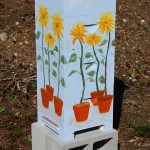FINALLY…..it seemed a long wait for the bees to arrive. I started reading, studying and researching everything about bees since October or so and now I’m finally a “beekeeper”. I can tell you first hand, despite all the research and discussion, nothing prepares you for the first time you unleash 10,000 bees into an open hive. Even with the bee suite on I kept thinking…..what if they turn on me????
Well, of course they didn’t. They are every bit as gentle as you treat them. I did get stung twice but both were my fault. One girl stung me because she got trapped under the wrist band of my watch (lesson..don’t wear that again) and the second bit me because I was not looking at what I was grabbing. I turned to pick up the top of the hive, grabbed it without looking and got stung for my carlessness.
This video is the installation of the first package into a new Warre hive. These are Italians. I also purchased a package of Carniolans which I installed the next day. I’ll post that video in the next week or so.
They have both settled nicely into their new homes and are drinking lots of sugar water as it is still pretty rainy.
Please feel free to comment below and link back if you have a website about bees that you have found interesting.




